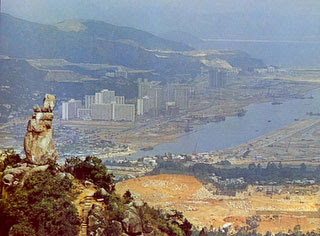Hong Kong's natural terrain is dominated by mountains and hills with steep slopes, many of which descend directly into the sea.
Geologie Hong Kongu (Geology of Honk Kong)
The seabed is relatively flat. The highest point in Hong Kong is Tai Mo Shan in the New Territories at 957 metres above Principal Datum. The deepest point is 66 metres below Principal Datum in Lo Chau Mun (Beaufort Channel) north of Po Toi Island.
The mountains consist primarily of volcanic rocks, with some of the lower hills formed of granite. Low-lying areas tend to be formed of granite or sedimentary rocks. In places, hill-slope debris forms a mantle over the bedrock and alluvium fills some of the valleys. Much of the seabed is covered by marine mud with some scattered sand banks.
Hong Kong lies on the southern edge of an ancient land mass. The oldest exposed rocks are Devonian fluvial sediments that were deposited 400 million years ago. The region was subsequently inundated by a shallow sea. Sediments from this period are represented by the carboniferous marble of Yuen Long and Ma On Shan. The sandy and muddy sediments of the Permain rocks of Tolo Harbour are of alternate marine and continental deposits.
From the Jurassic to Cretaceous periods, between 170 and 140 million years ago, Hong Kong was the scene of violent volcanic activity. Thick accumulations of lava and ash were deposited. The eruptions were associated with the development of several giant craters (calderas). At deeper levels, the volcanic deposits were intruded by molten magma, which slowly crystallised to form granite.
Igneous activity had ceased by 60 million years ago. Rocks now seen on the island of Ping Chau represent sediments laid down in a lake on the edge of a desert.
During the Quaternary period, spanning the last two million years, major glaciations in polar regions affected global sea level, which fell to 120 metres below the present level, leaving the site of present-day Hong Kong as much as 130 kilometres from the coast. At that time, the flat areas between what are now the islands of Hong Kong were part of an extended Pearl River flood plain. In interglacial periods, such as at the present time, the global sea level rose to its present level and higher, and marine sediments were deposited.
Geological maps etc.on: http://www.cedd.gov.hk/eng/about/organisation/org_geo_pln_map.htm
ZDROJ:http://www.yearbook.gov.hk,http://project-cool.blogspot.com

